Campo Morado

During the Mexican Revolution, one of the Revolutionary Zapatista mints in the state of Guerrero was at Campo Morado (Purple Camp), a mining camp-village in the mountains of the Sierra Madre del Sur, rugged mountains that dissect Guerrero. There is mining there today involving Canadian interests, the mines active or not depending on the price of metals, Mexican political involvement, and local activity, criminal or drug or other (which convinced the Canadians to pull out once, wanting someone else to buy the mine and the headaches). The mining is modern, extracting large amounts of low-grade ore from underground tunnel and stope, and mechanically/chemically extracting poly-metallic heavy sulfide concentrates, including silver and trace gold (but zinc and lead pay the bills), creating spoil of the sort generated by the method, usually fine-grained sandy ground-up rock and rock-mud, as tailings.
The high-grade (that is, nearsurface oxidized) ore is long gone, mined out back in the day when the Reforma mine at Campo Morado was described as the richest active mine in Guerrero, around 1910. In the same mineralized zone as Campo Morado, but even more isolated, is the mine at Suriana. There is another modern outfit poking around in the old Suriana workings, described, in a 1910 mining journal, The Engineering and Mining Journal, as 50 miles below the end of the railroad from Cuernavaca, at the Balsas station, the railroad bridge over the Rio Balsas. From there it was 8-10 hours on a flatboat and 8 miles inland from the river landing shared with Campo Morado, or 18-24 hours on a rough mountain trail, longer if you were hauling in heavy mining supplies from the railroad. Freighting became impossible during the rainy season, May to October. In 1910 the North Americans were excited about a proposed railroad branch down the river canyon, smelling opportunity, the ore was good and the mines were looking good if they could get supplies in and product out on the railroad, but it was the eve of the Revolution and the railroad was never built. It is still tough to get into Campo Morado, being 30 kilometers (over 18 miles) of dirt road in from the turnoff on the closest main road, the closest main town being even further.
Campo Morado was five hours overland from the river landing. The Reforma mine both mined and processed ore, so there were miners and millworkers, blasters and powder packers with oxen and mules and horses, blacksmiths, furnacemen (two smelters were reported at Campo Morado, one at Suriana), likely a few ancient guns to shoot food and protect the place. The Campo Morado product was raw (semi-refined) bullion, easier than heavy concentrates to export out of that tough country. Suriana, in that 1910 account, produced raw silver bullion of about 0.600 fine, the rest largely lead, containing gold in the melt.
The Guerrero revolutionaries under General Jesús Salgado were an early Zapatista ally, threatening the Americans at Suriana in 1912, who abandoned the place. Salgado became the Zapatista Governor of Guerrero after the fall of Chilpancingo, the state capital, in March 1914. Morelos, to the east, was agricultural, but Guerrero was rich in minerals and produced much of the distinctive Zapatista coinage during the Revolution.
Campo Morado was one of the major Zapatista mints in Guerrero, producing copper and silver coins mintmarked C.M., C.M.GRO., Co.Mo., ⋆ Co.Mo.⋆, and CAMPO Mo. The rare Suriana 1915 Dos Pesos was likely struck at Campo Morado with silver from Suriana. I understand that the same eagle die was used on both the Suriana and the Campo Morado with Stars 1915 Dos Pesos, and the same engraver prepared both sun dies (I have never had both coins side-by-side to compare, though). The Campo Morado with Stars was noted by old-time Texas dealer Harvey Bruns in 1996, “as rare as the Suriana”.
T. V. Buttrey, in A Neutron Activation Analysis of the Silver Coinage of Zapata, 1914-1915Buttrey, T. V. and Gordus, S. A., “A Neutron Activation Analysis of the Silver Coinage of Zapata, 1914-1915”, in The Mexican Revolutionary Reporter (MMR) #1, Verne R. Walrafen, editor and publisher. Available in the USMexNA online library., notes the relatively high fineness of silver (~0.900 fine) with trace gold of the Zapatista 1914 1- and 2-peso Campo Morado struck mintmarked CAMPO Mo. silver pesos in 1914, and Buttrey believes, from the die engraving and the alloy, the anonymous (no mintmark) Estado Guerrero 1914 UN PESO were engraved and struck at Campo Morado. This suggests raw silver bullion from Campo Morado was fire-refined by the smeltermen, although they could not part the gold from the silver (a different process than fire refining). The Taxco 1915 1-peso appears struck from ore mined and refined at Taxco, with little if any gold, a separate origin of the metal as suggested by assay.
Copper coins of 5, 10, 20 and 50 centavos and silver coins of 1 and 2 pesos are known. The copper coinage was mostly 1915 50-centavos, a useful coin, the same diameter as the 1-peso silver.
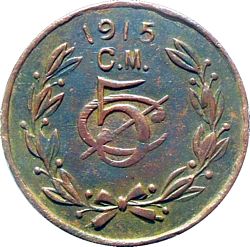
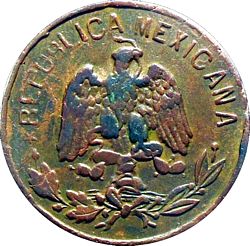
KM-653 Campo Morado 5c


KM-654 Campo Morado 10c
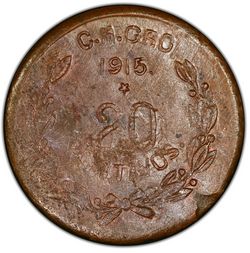

KM-655 Campo Morado 20c
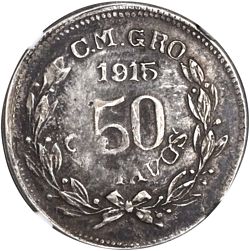

KM-657a Campo Morado50c (Stack’s-Bowers ANA Auction, 4 August 2017, lot 21285)
(This piece is struck in silver with a previously unlisted obverse die. KM refers to this issue as struck in billion, however XRF testing shows it to be struck in nearly pure silver. The metallic content is: Silver: 97.51, Copper: 1.66, Rhodium: 0.54, Gold: 0.23 & Zinc: 0.05.)


KM-659 Campo Morado $1 (Stack’s-Bowers ANA Auction, 25 August 2023, lot 57283)
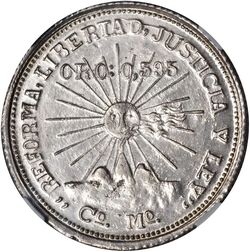
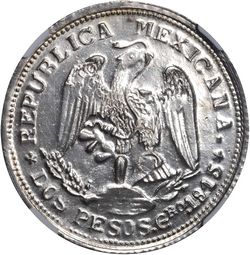
KM-660 Campo Morado $2 (Stack’s-Bowers ANA Auction, 4 August 2017, lot 21287)
